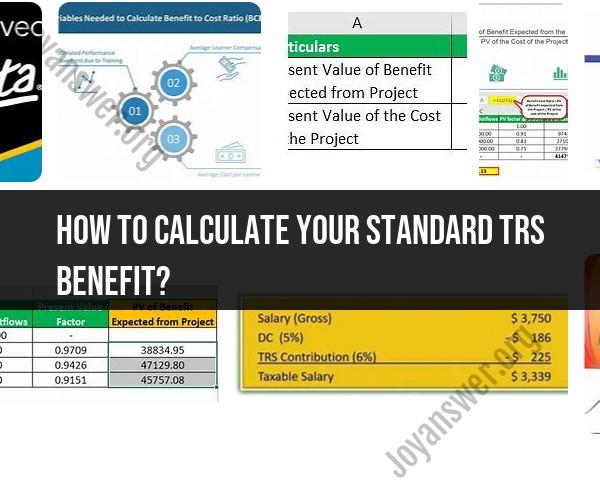How to calculate your standard TRS benefit?
Calculating your standard TRS (Teachers' Retirement System) benefit can be a complex process, as it typically involves several factors, such as your years of service, your final average salary, and the specific formula used by your TRS system. Here's a general step-by-step guide to help you understand the process:
1. Determine Your Eligibility:
- Verify your eligibility for TRS benefits. Eligibility criteria can vary by state or country, but generally, you need to be a member of the TRS system and meet specific service requirements, such as a minimum number of years of credited service.
2. Understand Your TRS Plan:
- Familiarize yourself with the details of your TRS plan. TRS systems may have different plans with varying benefit formulas and rules. Review the plan documents or contact your TRS administrator to understand which plan applies to you.
3. Determine Your Credited Service:
- Calculate your total years of credited service in the TRS system. Credited service typically includes your years of teaching or service in an eligible position. Some systems may also offer additional service credits for certain qualifications or years worked.
4. Determine Your Final Average Salary (FAS):
- Your FAS is a key component in the calculation of your TRS benefit. It's usually based on your average salary over a specific period, often the highest consecutive years of salary (e.g., the last three or five years) before retirement. The exact calculation method can vary by TRS system.
5. Identify the Benefit Formula:
- Different TRS plans use different benefit formulas. Common formulas include a percentage of your FAS multiplied by your years of service or a formula that considers both service and age at retirement. Refer to your TRS plan to determine the specific formula applied to your benefits.
6. Calculate Your Monthly Benefit:
- Using the benefit formula provided by your TRS plan, calculate your estimated monthly retirement benefit. This formula should take into account your years of credited service, FAS, and any other applicable factors.
7. Consider Optional Benefits:
- Some TRS systems offer optional benefits, such as survivor benefits or payment options. Evaluate whether you want to include any optional benefits in your calculation.
8. Review the TRS System's Resources:
- Many TRS systems provide online calculators or retirement planning tools on their websites. These tools can help you estimate your retirement benefits more accurately based on your specific circumstances.
9. Seek Professional Guidance:
- If you have complex financial situations, consider consulting with a financial advisor or retirement planner who specializes in TRS benefits. They can provide personalized advice and assist with your retirement planning.
It's essential to note that calculating your standard TRS benefit can vary significantly depending on your TRS system's rules and regulations, so it's crucial to consult your specific TRS plan documents and administrators for precise calculations. Additionally, the rules and formulas for TRS benefits may change over time, so stay informed about any updates or changes to your plan.
To calculate your standard TRS benefit, follow these steps:
- Determine your years of service credit. This is the number of years that you have contributed to TRS.
- Calculate your average salary. This is the average of your three highest annual salaries during your TRS membership.
- Multiply your years of service credit by 2.3%. This will give you your percent benefit.
- Multiply your average salary by your percent benefit. This will give you your annual TRS standard annuity.
- Divide your annual TRS standard annuity by 12. This will give you your monthly TRS standard annuity.
For example, let's say that you have 30 years of service credit and your average salary is $60,000. Your TRS standard benefit would be calculated as follows:
- Years of service credit: 30
- Percent benefit: 2.3% x 30 = 69%
- Average salary: $60,000
- Annual TRS standard annuity: $60,000 x 69% = $41,400
- Monthly TRS standard annuity: $41,400 / 12 = $3,450
It is important to note that this is just a general formula for calculating your standard TRS benefit. Your actual benefit may vary depending on your specific circumstances. You can contact your TRS administrator for more information.
Tips for maximizing your TRS benefit:
- Start contributing to TRS as early as possible. The earlier you start contributing, the more time your money has to grow.
- Increase your TRS contributions each year, if possible. This will help you save more money for retirement.
- Take advantage of the tax advantages of TRS plans.
- Review your TRS benefits regularly and make sure that you understand your options.
- Seek financial advice from a qualified professional to help you develop a retirement plan that meets your individual needs.
Personalized retirement planning
Calculating your TRS benefits is an important step in personalized retirement planning. However, it is important to consider all of your retirement income sources, such as Social Security and personal savings, when developing a retirement plan. You may also want to consider working with a financial advisor to create a personalized retirement plan that meets your individual needs and goals.












